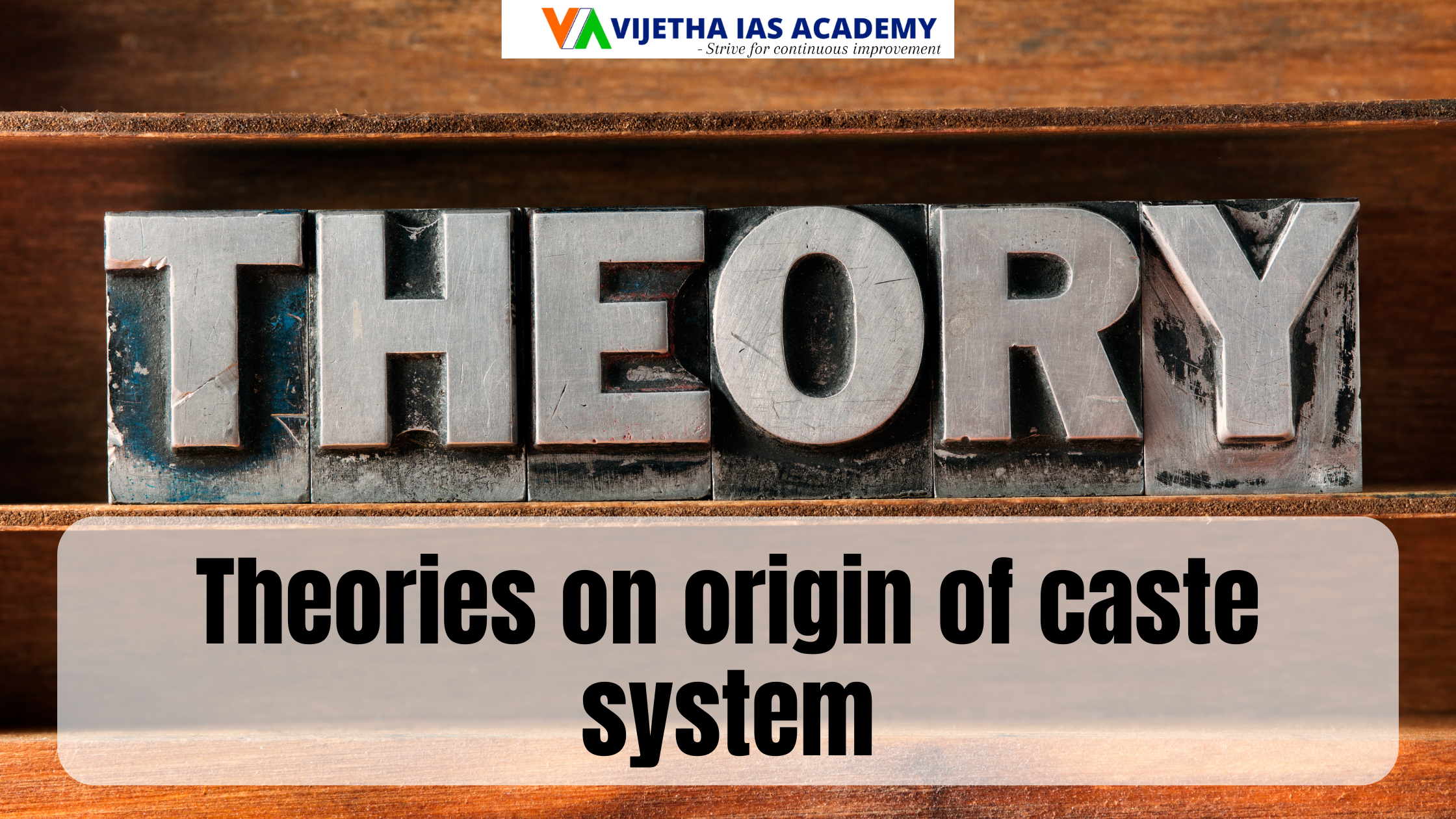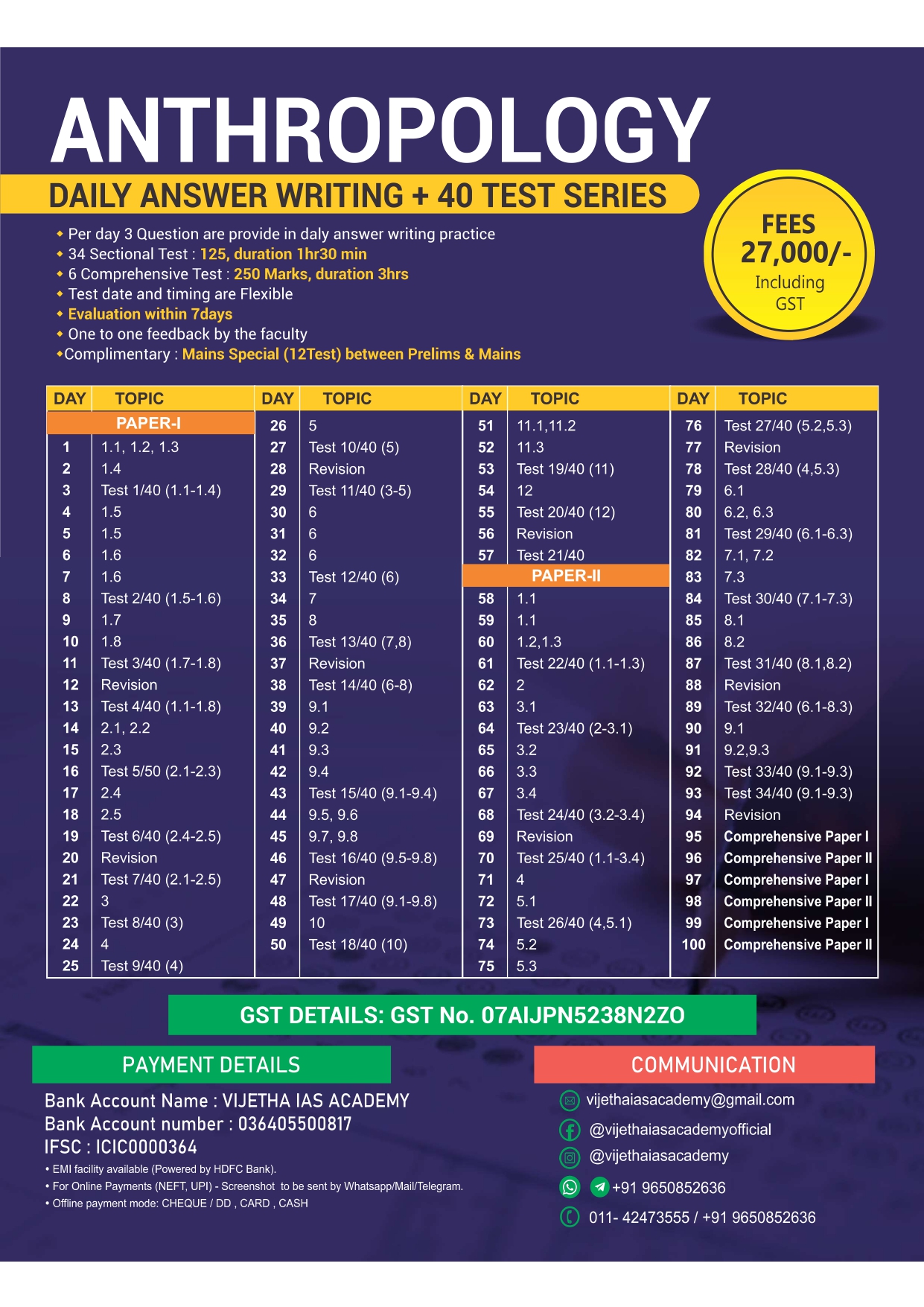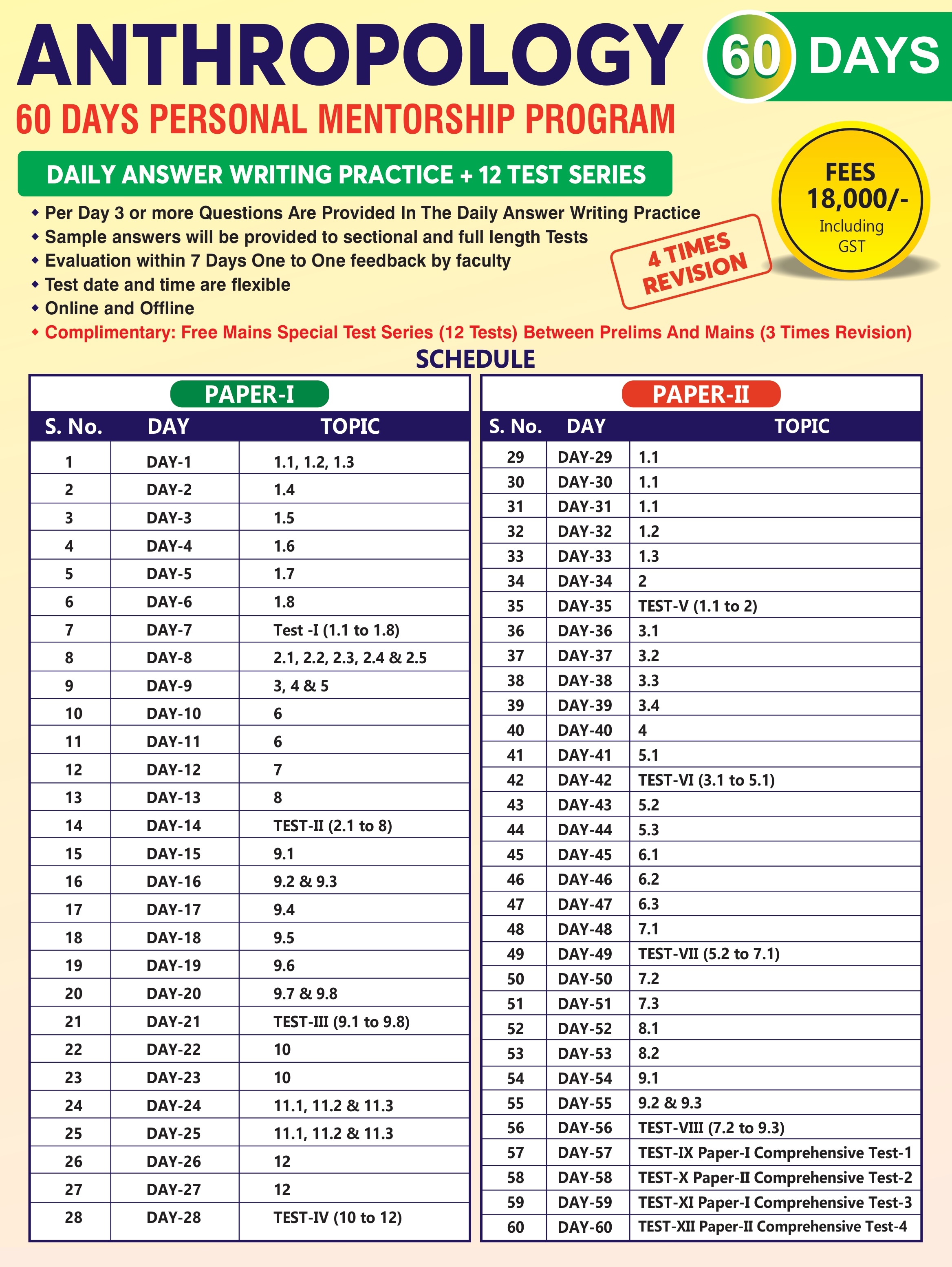Discuss the theories on origin of caste system and its criticism in India. Differentiate between caste, class and race. (15 Marks) Anthropology Optional Paper CSE 2024
Discuss the theories on origin of caste system and its criticism in India. Differentiate between caste, class and race. (15 Marks) Anthropology Optional Paper CSE 2024
-
Author : Vijetha IAS
-
Date : {{ formatDate("Wed Oct 02 2024 14:35:37 GMT+0530 (India Standard Time)") }}
-
Category : Daily News,

Discuss the theories on origin of caste system and its criticism in India. Differentiate between caste, class and race.
(15 Marks) Anthropology Optional Paper CSE 2024
Introduction
The caste system in India is one of the most deeply ingrained social structures, traditionally organizing society into hierarchical groups based on occupation, birth, and social status. The origins of the caste system have been debated by scholars, and several theories have been proposed to explain its evolution. Alongside caste, social structures like class and race also contribute to stratification, though they differ in form and function. Understanding these distinctions is crucial for comprehending the broader dimensions of social inequality.
Main Body
Theories on the Origin of the Caste System:
Racial Theory:
Proposed by British scholars during the colonial era, this theory suggests that the Aryan invasion of the Indian subcontinent led to the creation of the caste system. The theory posits that the Aryans established themselves as a superior race, placing the indigenous Dravidians in lower strata of society.
Criticism: This theory has been criticized for its Eurocentric biases and racial undertones. Modern genetics has challenged the simplistic racial division between Aryans and Dravidians, pointing to a more complex population history of India.
Occupational Theory:
This theory argues that the caste system originated as a division of labor based on occupations. Different groups specialized in different tasks such as priests (Brahmins), warriors (Kshatriyas), traders (Vaishyas), and laborers (Shudras). Over time, these roles became hereditary, solidifying into the rigid caste hierarchy.
Criticism: Critics argue that while occupational divisions existed, the theory doesn’t fully explain the social rigidity and endogamy characteristic of the caste system. Additionally, it overlooks the religious and ritual aspects that reinforce caste distinctions.
Religious Theory:
The Varna system as described in ancient Hindu texts is often cited as the religious foundation of the caste system. It divides society into four varnas (Brahmin, Kshatriya, Vaishya, and Shudra), based on duties and qualities, and assigns specific roles to each.
Criticism: This theory fails to account for the rigidity and social inequalities of the actual caste system. The varna system is often seen as more flexible than the caste system, which developed later with more rigid social boundaries and hierarchical practices.
Evolutionary and Functionalist Theory:
Some sociologists argue that the caste system evolved as a social structure to maintain order and stability in a complex agrarian society. The system functioned as a social control mechanism, ensuring that each group contributed to the economic and social functioning of the society.
Criticism: While it explains the stability of the system, it is criticized for justifying caste-based inequalities and not addressing the exploitative nature of the caste hierarchy.
Criticism of the Caste System:
The caste system has been widely criticized for promoting social inequality, discrimination, and exclusion. It has perpetuated untouchability, denied basic human rights to lower castes, and restricted upward social mobility.
Reformers like Dr. B.R. Ambedkar have strongly opposed the caste system, advocating for equality and abolition of caste-based discrimination. Modern legal frameworks, including the Constitution of India, prohibit caste-based discrimination, though it persists in various forms in contemporary India.
Difference between Caste, Class, and Race:
Caste:
Basis: Hereditary social group based on birth, occupation, and rituals.
Structure: Rigid hierarchy with little social mobility. Caste is determined by birth and individuals remain in the same caste throughout life.
Example: The caste system in India, where individuals are born into a specific caste like Brahmin, Kshatriya, or Dalit.
Class:
Basis: Economic standing and control over resources, wealth, and power.
Structure: More fluid than caste, allowing for social mobility through education, occupation, or wealth accumulation. Class is determined by economic factors, not birth.
Example: The distinction between upper, middle, and lower classes based on income and wealth distribution.
Race:
Basis: Physical characteristics like skin color, facial features, and genetic ancestry.
Structure: While race is socially constructed, it often forms a basis for systemic discrimination. Like caste, race is often hereditary, but its social significance varies across societies.
Example: Racial divisions in societies like the U.S., where race influences social status and access to resources.
Conclusion
The caste system has complex origins, influenced by racial, occupational, and religious factors. It has been a key mechanism of social stratification in India but has also drawn criticism for perpetuating inequality and exclusion. When compared to class and race, caste is unique for its rigid, birth-based hierarchy. However, like class and race, it functions as a marker of social identity and inequality. Understanding these distinctions helps in addressing the multifaceted nature of social stratification and advancing social justice.
Anthropology Test Series Programme (Online + Offline))
We provide Anthropology Daily Answer Writing a range of programs designed to cater to various stages of UPSC preparation. Whether you're just starting out, have attempted the Mains before, or are getting ready for Mains 2024, we have the right option for you. Allow us to assist you in choosing the course that best fits your needs.
|
Level of Preparation |
Test Series Program |
Test Series Content |
Test Schedule |
|
Self-study of Anthropology Optional |
Anthropology 100 Days Personal Mentorship Program |
Daily answer writing, 34 sectional tests, 6 comprehensive tests, and complementary Mains Special 12 tests (between prelims and mains) |
|
|
Revise whole syllabus through Daily Answer Writing Practice and Tests |
Anthropology DAW Mentorship Program |
Daily Answer Writing Practice and 8 sectional and 4 Full Length tests |
|
|
Revise whole syllabus through Sectional and Full Length Tests |
Anthropology Tier- I T-40 Test Series |
34 Sectionals and 6 Full Length Tests |
|
|
Written Mains earlier and need more practice |
16-Anthropology Tier II Test Series |
10 sectional and 6 Full-Length Tests. |
|
|
Cleared Prelims 2023 and are preparing for Mains 2023 |
Mains Special 12 Tests program |
8 Sectional and 4 Full-Length Tests |
ANTHROPOLOGY MAINS SPECIAL COURSES
Enroll in our Anthropology Mentorship Program today and take the first step towards achieving your UPSC goals!
1) If you are going for Self study of Anthropology Optional and looking for a Comprehensive Program that includes Daily Answer Writing, 34 Sectional tests, 6 Comprehensive tests, and Complementary mains special 12 tests (between prelims and mains), our Anthropology 100 Days Personal Mentorship Program is the perfect choice.
2) If you want to revise Whole Syllabus through Daily Answer Writing Practice and 8 sectional and 4 full length tests, then our Anthropology DAW Mentorship Program is the best fit for you.
3) If you want to revise Whole Syllabus through 34 Sectionals and 6 Full Length Tests then Anthropology Tier- I T-40 Test Series is for you.
4) If you have written Mains earlier and need more practice, then our 16-Anthropology Tier II Test Series is a great option. This test series includes 10 sectional and 6 full-length tests.
5) if you have cleared Prelims 2023 and are preparing for Mains 2023,our Mains Special 12 Tests program is a must-have. This program includes 8 sectional and 4 full-length tests to help you prepare for the big day.
For more information on Vijetha IAS Academy’s Anthropology mentorship programs Deatils : https://vijethaiasacademy.com/anthropology-test-series
Anthropology 100 Days Personal Mentorship Program ( 7 + 3 Times Revision )

Anthropology 60 Days Personal Mentorship Program ( 4 + 3 Times Revision )

For more information: https://vijethaiasacademy.com/anthropology-test-series
Details Of Anthropology Classes Program
Top Anthropology Optional IAS Coaching Center in Delhi Vijetha IAS Academy | Best Anthropology Optional IAS Coaching in Delhi
Fee Structure:
- Tier 1: Rs. 55,150/- (3 Years Validity of Offline/Live Batch)
- Tier 2: Rs. 42,000/-
- Tier 3: Rs. 36,000/-
Batch Size: 50 – 60 Students
UPSC Notes
Anthropology Optional IAS Coaching Notes, IAS Exam Preparation Booklets, IAS optional coaching Notes, UPSC Coaching Notes, Video Lectures, Live Classes with faculty, Chat Facility Available
Teachers Name: N P Kishore Sir
Past Result
- Last Years Result 2023
- 35 Total Selections in CSE 2023
Google Reviews: 4.9 out of 5 stars
Website: Vijetha Anthropology Optional IAS Coaching in Delhi (https://vijethaiasacademy.com)
Faculties of Vijetha IAS Academy
- N P Kishore Sir
Features
- Vijetha IAS Academy offers Online and offline Courses for better preparation of Anthropology Optional Strategy for UPSC in Delhi.
- For better Anthropology optional Exam Preparation, Vijetha IAS Academy Delhi Conducts the Motivational IAS Session.
- Vijetha IAS Academy provides you with the CASE STUDIES on the pattern of the real-time IAS Exam which is helpful for better preparation of the Best Coaching for UPSC Anthropology Optional Optional IAS Examination.
- DAW & WAW – Revision Through Daily & Weekly Answer Writing Practice is offered by Vijetha IAS Academy for better result of the Anthropology Optional IAS examination.
Advantages of joining Vijetha IAS Academy
- Best Faculties for Anthropology Optional IAS Coaching in Delhi
- Best facilities, infrastructure and updated Case Studies Booklets and Notes for better preparation of the Anthropology Optional IAS Examination in Delhi.
- Best result in Past years for Anthropology Optional Strategy for UPSC Examination in Delhi
- Best Rated coaching institute for Anthropology Optional IAS Examination in Delhi.
- Vijetha IAS Academy also provides recorded lectures videos, notes which is very helpful for better preparation of Anthropology Optional IAS Coaching in Delhi
Fees Structure of Vijetha IAS Academy
|
Tier 2 |
Tier 1 |
Tier 3 |
BATCH STARTS FROM |
|
42,000/- |
55,150/- (3 Years Validity Offline/Live Batch) |
36,000/- |
REGISTRATION – START |
Fees Structure of Vijetha IAS Academy
|
Course Name |
Fees Amount |
Course Duration |
|
GS Offline (Pre + Mains+ CSAT) with Essay+Answer Writing |
Rs.99,000 (Including GST) |
400+ Days |
|
GS Online |
Rs.18,999 (Including GST) |
400+ Days |
|
GS Mentorship Programme |
Rs.29,999 (Including GST) |
1 Year |
For more information on our courses, visit our Anthropology Courses page. Explore our Test Series and Online Courses for flexible learning options.
Vijetha IAS Academy
Add. 2nd Floor, 50, Shankar Road, Block 7, Old Rajinder Nagar, Rajinder Nagar, New Delhi, Delhi 110060
MOB. 096508 52636
Open 7 Am : Closes 9 PM
Keywords: origin of caste system, caste system theories, caste vs class vs race, anthropology 2024 question paper, Anthropology optional subject question paper 2024, Anthropology optional 2024 question paper, Anthropology Optional Coaching UPSC, Vijetha IAS Academy Anthropology, Anthropology crash course UPSC, Anthropology daily answer writing UPSC, Kishore sir Anthropology

-1731663946320.webp)